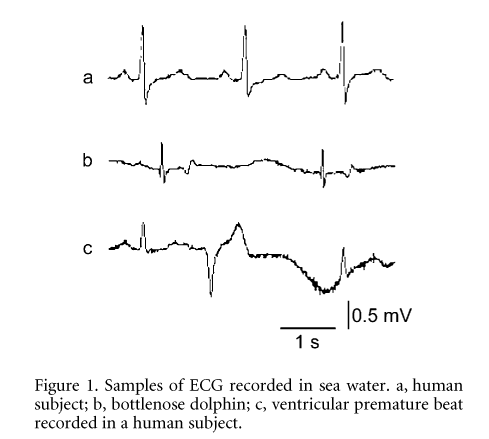A limited number of studies have been performed on the cardiac function of humans (Istepanian & Woodward, 1997) and cetaceans (Williams et al. 1993) in the marine environment. In most cases procedures and techniques for recording activities were invasive (King et al. 1953; Wardle & Kanwisher, 1974) or under non-physiological conditions (Hamlin et al. 1970).
Here we present an easy-to-use and easy-to-assemble, portable, non-harmful, waterproof recorder for monitoring electrocardiograms in sea water. The instrument was worn by the subject, freely carrying it during normal swimming activity. Three stainless-steel electrodes, each inserted into a plastic suction cup, were connected to a Holter recorder (QRS-LX16 from High Technology Devices srl) which pre-amplified, filtered and converted signals to digital, storing them in an 8-bit flash memory card. A polyethylene waterproof box, measuring 15 X 4 X 9 cm and weighing 660 g, was designed to protect the electric circuit from the marine environment. Data were transferred to a receiver system for analysis through dedicated software. A 500 Hz sampling frequency was used, obtaining up to 2 h of recording.
Heart activity monitoring in sea water was performed on five humans (Homo sapiens sapiens) and six bottlenose dolphins (Tursiops truncatus), awake and without anaesthesia. Experimental sessions took place on the surface and at a depth of 35 m in open calm sea with humans, and in 4Ð6 m deep tanks with dolphins. In humans, positive and negative electrodes were placed to the left and right of the hemi-thorax, respectively, below the pectoralis major muscle. The reference electrode was placed on the right iliac crest. In dolphins positive and negative electrodes were symmetrically positioned on the ventral thorax, to the left and right, respectively, of the middle of the sternum, caudally to pectoral fins. The reference electrode was placed on the belly region. The recorder was placed cephalically to the dorsal fin.
ECGs obtained showed a good signal-to-noise ratio which lasted for the whole recording period both in humans (Fig. 1a) and dolphins (Fig. 1b). The system reliably monitored anomalous cardiac activity detected in a human (Fig. 1c), as well as diving-induced bradycardia. Specifically, human heart rate decreased from 100 ± 3.6 beats min-1 (b.p.m., mean ± S.E.M.) on the surface to 88.6 ± 3.2 b.p.m. (P < 0.05, Student’s paired t test) at 35 m, while bottlenose dolphin heart rate decreased from 79.5 ± 6.5 to 42.3 ± 4.2 b.p.m. (P < 0.05, Student’s paired t test).
In conclusion, adoption of this instrument represents a reliable and powerful tool for future physiological studies. The innovative technical approach opens up new prospects in diving sports as well as in medical and veterinary diagnostic fields.
We are grateful to Zoomarine, Portugal and the Genoa Aquarium, Italy, for training animals, as well as to a group of students from the University of Cagliari, Italy, who participated as experimental subjects. This project was partly sponsored by the Italian Ministry of Universities and Scientific Research and by the Genoa Aquarium.
All procedures accord with current National guidelines.

